The Sanshin Building - by Lyle (Hiroshi) Saxon, Images Through Glass, Tokyo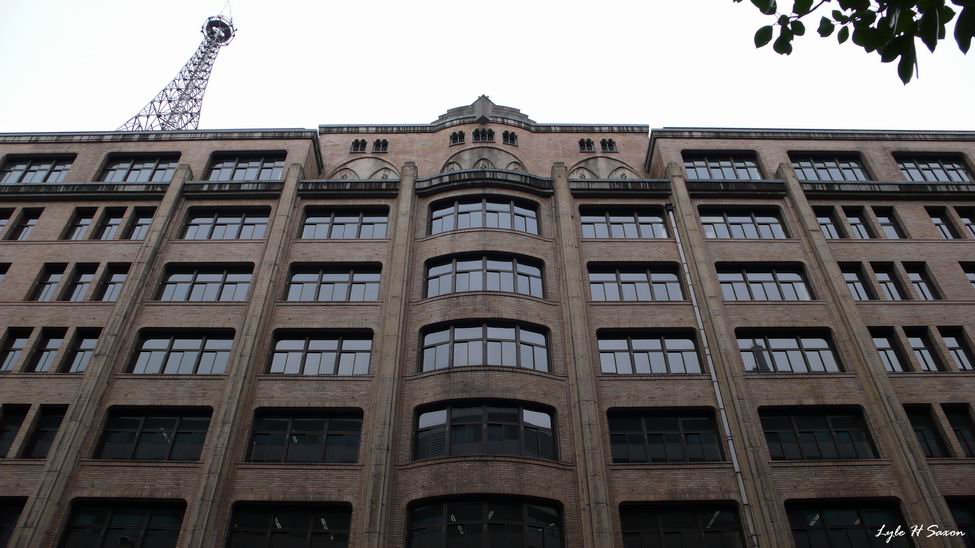 Japan's old temples and shrines from hundreds of years ago are generally preserved, but once western influence radically altered the style and construction of buildings, the new buildings were appreciated when new as something exciting, but not deemed cultural and thus were (and still are, unfortunately) considered fair game to destruction. In the early years of Japan's switch to western style buildings (which are now world-style buildings - common to nearly every country), I don't imagine people were concerned about destroying these new things "without culture", but after more than 150 years, there are some old buildings with a lot of character and culture in their walls that really ought to be preserved. One such building is the Sanshin Building in Yurakucho....  The building is most impressive on the inside, and doesn't automatically impress people who casually see it from the outside - until you take a good look at it and take in the details. The more you look, the more you realize how radically different the building is from modern buildings, particularly with respect to the windows - which are actually openable (gasp! shocking!), allowing for occupants to opt out of stale and recycled air. 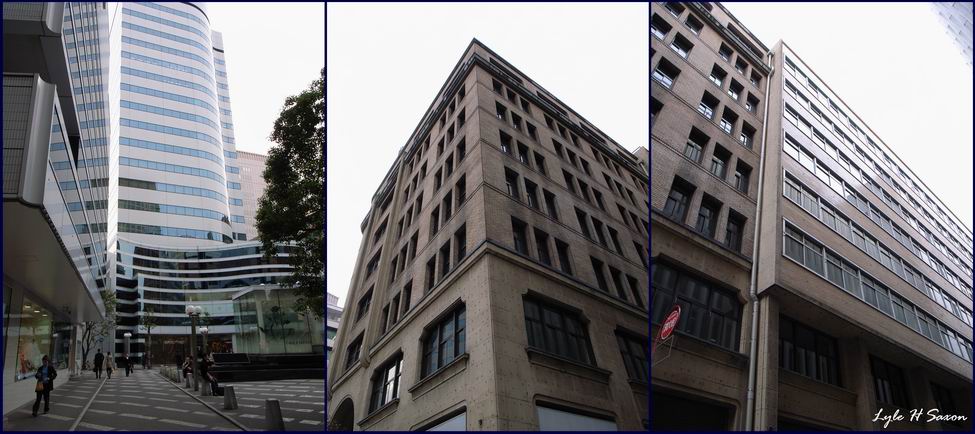 (Left above) - Typical new sealed boxes are not all bad of course, but a city has more character and soul if it keeps some of its old structures to stand side-by-side with the new ones. All new is not all good.... (Right above) - This section of the building is quite odd - on the back side, it looks like they ripped off the side of the building and put on a modern (at the time of modification anyway) section of box providing more space inside and more light via a solid bank of windows. This aspect of the building is the most unfortunate - it hurts both its historical value and its aesthetic appeal, but it's overlookable - being on the back side and with the other three sides being unmolested. (Check out the pictures here to see what was there before - a balcony! Seeing how much lost space that would mean for the upper floors, I can understand wanting to make use of the space, but the outside appearance is not very nice.) 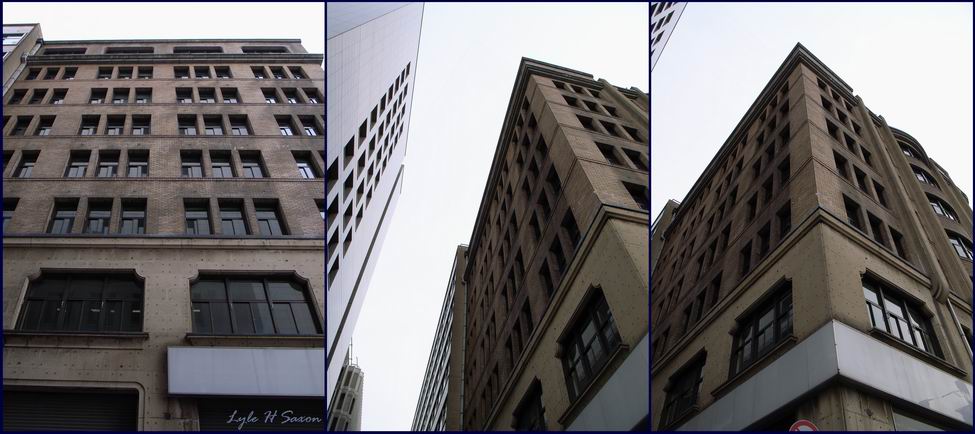 (Below left) - The end of the building, facing Hibiya Park. You used to be able to enter the building here and walk the full length of it down a kind of two-story arcade, with more ambiance than any other building I can think of in Tokyo. In fact, if it weren't for that very cool arcade, I probably wouldn't bother to post this page; the arcade should definitely be saved, and - after looking over the whole building - I think it would be a great place to fill up with art galleries and restaurants.... 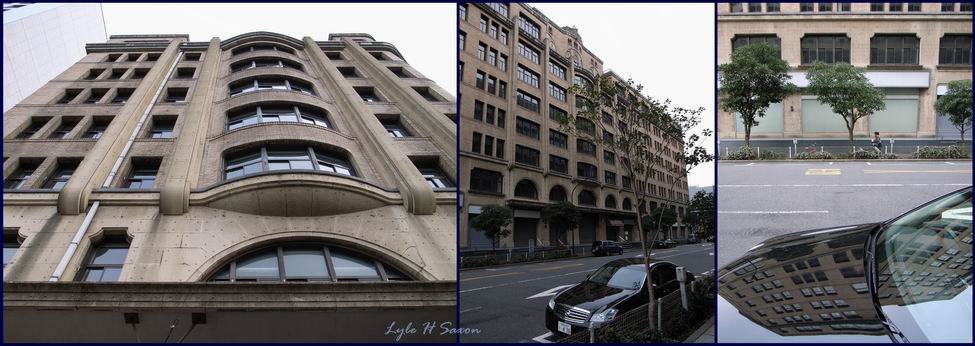 I suppose the owners of the building say that it would cost too much to restore the building, but how much does it cost to rip it down and build another? What cost to the cultural identity of Tokyo, a city begging for a little more culture in its architecture?  The external pictures I took on a weekend, when the building was closed and looking a bit forlorn - the interior pictures were taken on a weekday evening, when half of the first floor (they threw up a wall to block off the other half) is open for the sole remaining holdout against leaving the building - the New World Service Bar & Grill (below right - there's no actual bar inside, but they do serve alcohol). It's hard to see in the photo, but there is actually an upstairs to the restaurant (taking advantage of the high ceilings of old buildings), with the staircase railing just visible on the right side of the photo).  From hand-written notes while having dinner in the New World Service Bar & Grill: (November 9th, 2006) This place has a few variations on its name - one is "New World Snack Bar" and another is "New World Service Bar & Grill". The last hold-out in the Sanshin Building, which could - in a way - be said to represent a huge paradox about Tokyo (in traditional Japan), where you have to search long and hard for anything old, and by the time you do find it, as often as not, it's gone the next time you go back for another look. This building, while fairly nondescript-looking from the outside (depending on the angle), is a really cool and interesting building on the inside - with stone underfoot on the first floor, wood here & there and gargoyles(!) looking down at you from the second-level inside balcony. (November 16th, 2006) Back again. Last time I ordered "Ginger Pork", and as I started eating it, I looked over to see two women (in their twenties) being served large hamburgers, so this week I've ordered a "Deluxe Hamburger". Ah... mustard - specifically, the smell of it - takes me back to somewhere on the other side of the ocean when it was an ordinarily welcome aroma in restaurants serving hamburgers; now it's suddenly an exotically welcome aroma. Pleasant piano music tinkles in the background as I sit in florescent tube-free incandescent heaven awaiting my hamburger. Ah! Here it is! Now to get some of that mustard onto it! (November 17th, 2006) Back again - I thought I'd try something new, but I went for the "Deluxe Hamburger" again. The trend to chain stores is an unfortunate one - individual places like this one-of-a-kind restaurant have so much more character! The place is almost full tonight - Friday after all. After sitting here last night, I walked around the building and discovered its long front side looking rather majestic in some way felt more than can be described with words.... (Below middle) - The side of the building and the street it faces on the Yurakucho side. Looking straight ahead - a sea of modern buildings... isn't there room for one proud old building to stay on for a few more decades at least? 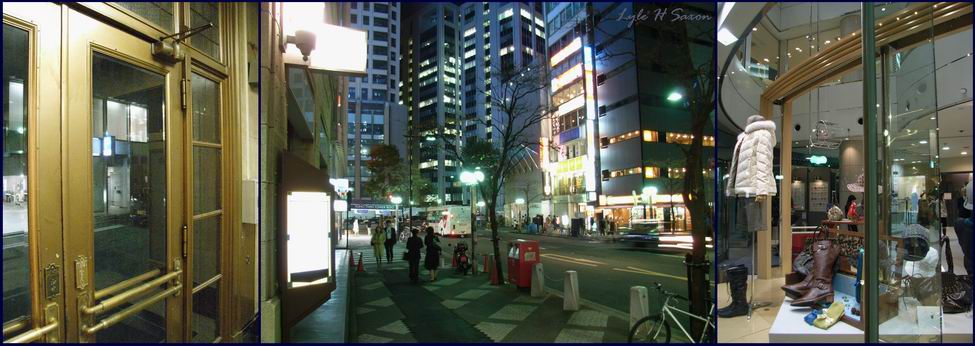 (Below) - A ten-minute walk from the Sanshin Building takes you to ultra-fashionable Ginza, with interesting window displays and fashionable people walking about. Ginza is also known for its galleries, but they're scattered around and sometimes hard to find. If they made the Sanshin Building a sort of retro-art space, with everything in the original style in which it was created, it would be a great success I think. The key would be authenticity however - you would have to have authentic artists - not empty names. The city is already awash in "brand" things; it would nice to promote more original art I think. 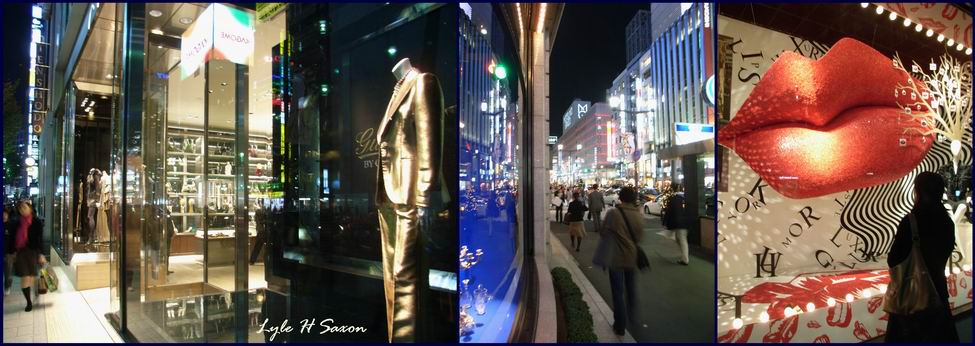 Copyright 2006 by Lyle (Hiroshi) Saxon, Images Through Glass, Tokyo |